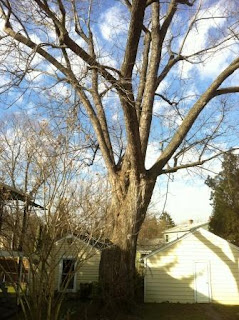
Two visitors with arboreal and horticultural authority greater than mine have tentatively identified it as a silver maple, and my cursory consultation of tree-identifying resources on the internet has not undermined them.
During my sister and brood's visit in the region for a recent holiday, they all piled into the Suburban and, appropriately, came over to check out the new digs.
As we stood idly appreciating the back yard, the question of the tree's age arose, my brother-in-law imagining it might be a certifiably Revolutionary War-era tree. We were all aware that a tree's age could be determined by cutting it down and counting its rings. Somebody pined aloud for the availability of an information resource that might describe non-destructive methods of estimating the age of trees, and then they piled back into the Suburban to head (again, appropriately) over to the other in-laws' for the feast.
Before they made it to their first stoplight, my sister texted me a well-regarded answer to the question from ehow.com, which estimates a tree's age by multiplying its diameter by a "growth factor rate" specific to the type of tree: age = C/pi x Gf.

So, I grabbed my trusty ancestral tape measure, wrapped some crusty old clothesline around the trunk, marked and measured it for the circumference, and did the math.
(174/3.14) x (the "growth factor" for silver maples, we're told, is 3) = 166.24 years, suggesting that, if not revolutionary, it is likely a pre-Civil War tree. Assuming the proper identification of the tree and soundness of International Society of Arboriculture's method.
A local news item covering the removal of an ailing silver maple of similar, if somewhat broader, proportions from the courtyard of a local government building features footage of its mostly-hollow trunk, so, maybe counting the rings would not have been so easy.